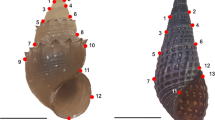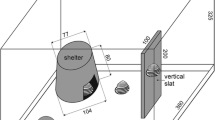Abstract
Ectotherms from sunny and hot environments need to cope with solar radiation. Mediterranean land snails of the superfamily Helicoidea feature a behavioural strategy to escape from solar radiation-induced excessive soil heating by climbing up vertical objects. The height of climbing, and also other parameters like shell colouration pattern, shell orientation, shell size, body mass, actual internal and shell surface temperature, and the interactions between those factors may be expected to modulate proteotoxic effects in snails exposed to solar radiation and, thus, their stress response. Focussing on natural populations of Xeropicta derbentina, we conducted a ‘snapshot’ field study using the individual Hsp70 level as a proxy for proteotoxic stress. In addition to correlation analyses, an IT-model selection approach based on Akaike’s Information Criterion was applied to evaluate a set of models with respect to their explanatory power and to assess the relevance of each of the above-mentioned parameters for individual stress, by model averaging and parameter estimation. The analysis revealed particular importance of the individuals’ shell size, height above ground, the shell colouration pattern and the interaction height × orientation. Our study showed that a distinct set of behavioural traits and intrinsic characters define the Hsp70 level and that environmental factors and individual features strongly interact.





Similar content being viewed by others
References
Anderson DR, Burnham KP, Thompson WL (2000) Null hypothesis testing: problems, prevalence, and an alternative. J Wildl Manag 64:912–923
Arad Z, Mizrahi T, Goldenberg S, Heller J (2010) Natural annual cycle of heat shock protein expression in land snails: desert versus Mediterranean species of Sphincterochila. J Exp Biol 213:3487–3495
Aubry S, Labaune C, Magnin F, Kiss L (2005) Habitat and integration within indigenous communities of Xeropicta derbentina (Gastropoda: Hygromiidae), a recently introduced land snail in South-Eastern France. Divers Distrib 11:539–547
Bradford M (1976) A rapid and sensitive method for the quantitation of microgram quantities of protein utilizing the principles of protein-dye binding. Anal Biochem 72:248–254
Burnham KP, Anderson DR (2002) Model selection and multimodel inference: a practical information-theoretical approach. Springer, New York
Burnham KP, Anderson DR (2004) Multimodel inference: understanding AIC and BIC in model selection. Sociol Methods Res 33:261–304
Clusella Trullas S, van Wyk JH, Spotila JR (2006) Thermal melanism in ectotherms. J Therm Biol 32:235–245
Cowie RH (1985) Microhabitat choice and high temperature tolerance in the snail Theba pisana (Mollusca:Gastropoda). J Zool Lond (A) 207:201–211
Cowie RH (1990) Climatic selection on body colour in the land snail Theba pisana (Pulmonata: Helicidae). Heredity 65:123–126
Dittbrenner N, Lazzara R, Köhler H-R, Mazzia C, Capowiez Y, Triebskorn R (2009) Heat tolerance in Mediterranean land snails: histopathology after exposure to different temperature regimes. J Molluscan Stud 75:9–18
Evgen’ev MB, Garbuz DG, Shilova VY, Zatsepina OG (2007) Molecular mechanisms underlying thermal adaptation of xeric animals. J Biosci 32:489–499
Feder ME, Hofmann GE (1999) Heat-shock proteins, molecular chaperones, and the stress response: evolutionary and ecological physiology. Annu Rev Physiol 61:243–282
Helmuth B, Broitman B, Yamane L, Gilman SE, Mach K, Mislan KAS, Denny MW (2010) Organismal climatology: analyzing environmental variability at scales relevant to physiological stress. J Exp Biol 213:995–1003
Hofmann GE, Somero GN (1996) Interspecific variation in thermal denaturation of proteins in the congeneric mussels Mytilus trossulus and M. galloprovincialis: evidence from the heatshock response and protein ubiquitination. Mar Biol 126:65–75
Hoshino T, Matsuda M, Yamashita Y, Takehara M, Fukuya M, Mineda K, Maji D, Ihn H, Adachi H, Sobue G, Funasaka Y, Mizushima T (2010) Suppression of melanin production by expression of HSP70. J Biol Chem 285:13254–13263
Irvine DR, Hibbs DE, Shatford JPA (2009) The relative importance of biotic and abiotic controls on young conifer growth after fire in the Klamath-Siskiyou region. Northwest Sci 83:334–347
Johnson JB, Omland KS (2003) Model selection in ecology and evolution. Trends Ecol Evol 19:101–108
Kempster V, Charwa S (2003) Soil surface temperature and mortality in land snails: implications for successful management. Aust J Agric 43:1351–1356
Köhler H-R, Triebskorn R, Stocker W, Kloetzel PM, Alberti G (1992) The 70kD heat shock protein (Hsp 70) in soil invertebrates: a possible tool for monitoring environmental toxicants. Arch Environ Contam Toxicol 22:334–338
Köhler H-R, Zanger M, Eckwert H, Einfeldt I (2000) Selection favours low Hsp70 levels in chronically metal-stressed soil arthropods. J Evol Biol 13:569–582
Köhler HR, Lazzara R, Dittbrenner N, Capowiez Y, Mazzia C et al (2009) Snail phenotypic variation and stress proteins: do different heat response strategies contribute to Waddington’s widget in field populations? J Exp Zool B Mol Dev Evol 312B:136–147
Lewis S, Handy RD, Cordi B, Billinghurst Z, Depledge MH (1999) Stress proteins (Hsps): methods of detection and their use as an environmental biomarker. Ecotoxicol 8:351–368
Lyons C, Dowling V, Tedengren M, Gardestrom J, Hartl MJ, O’Brien N, Van Pelt F, O’Halloran J, Sheehan D (2003) Variability of heat shock proteins and glutathione S-transferase in gill and digestive gland of blue mussel, Mytilus edulis. Mar Environ Res 56:585–597
Machin J (1968) The permeability of the epiphragm of terrestrial snails to water vapor. Biol Bull Mar Biol Lab, Woods Hole 134:87–95
Mayer MP, Bukau B (2005) Hsp70 chaperones: cellular functions and molecular mechanism. Cell Mol Life Sci 62:670–684
Mazek-Fialla K (1934) Die Lebensweise xerophiler Schnecken Syriens, Griechlands, Dalmatiens und der Türkei und die Beschaffenheit ihrer subepithelialen Drüsen. Z Morphol Ökol Tiere 28:445–468
Mizrahi T, Heller J, Goldenberg S, Arad Z (2009) Heat shock proteins and resistance to desiccation in congeneric land snails. Cell Stress Chaperones 15:351–363
Mukhopadhyay I, Nazir A, Saxena DK, Chowdhuri DK (2003) Heat shock response: Hsp70 in environmental monitoring. J Biochem Mol Toxicol 17:249–254
Nakano K, Iwama G (2002) The 70-kDa heat shock protein response in two intertidal sculpins, Oligocottus maculosus and O. snyderi: relationship of hsp70 and thermal tolerance. Comp Biochem Physiol A Mol Integr Physiol 133:79–94
Pomeroy DE (1966) The ecology of Helicella virgata and related species of snails in South Australia. PhD thesis, University of Adelaide
Pörtner HO, Farrell AP (2008) Ecology: physiology and climate change. Science 322:690–692
Scheil AE, Gärtner U, Köhler H-R (2012) Colour polymorphism and thermal capacities in Theba pisana (O.F. Müller 1774). J Therm Biol
Silvertown J, Cook LM, Cameron RAD, Dodd M, McConway K, Worthington J, Skelton P, Anton C, Bossdorf O, Baur B, Schilthuizen M, Fontaine B, Sattmann H, Bertorelle G, Correia M, Oliveira C, Pokryszko B, Ożgo M, Stalažs A, Gill E, Rammul Ü, Sólymos P, Féher Z, Juan X (2011) Citizen science reveals unexpected continental scale evolutionary change in a model organism. PLoS One 6:e18927. doi:10.1371/journal.pone.0018927
Stevenson RD (1985) The relative importance of behavioral and physiological adjustments controlling body temperature in terrestrial ectotherms. Am Nat 126(3):362–386
Symonds MRE, Moussalli A (2010) A brief guide to model selection, multimodel inference and model averaging in behavioural ecology using Akaike’s information criterion. Behav Ecol Sociobiol 65:13–21
Triebskorn R, Köhler H-R (1996) The impact of heavy metals on the grey garden slug, Deroceras reticulatum (Müller): metal storage, cellular effects and semi-quantitative evaluation of metal toxicity. Environ Pollut 93:327–343
Yom-Tov Y (1971) Body temperature and light reflectance in two desert snails. Proc Malacol Soc Lond 39:319–326
Acknowledgments
We are grateful to Tal Seifan for his help with the statistical analysis. Nik Triebskorn and Tim Triebskorn assisted during sampling in the field. Thanks go also to Lucile Delay for providing access to one of the sampling areas and to Thomas Wilke and Sergej Sereda (Giessen University) for molecular species determination. The study was financed by the German Research Council (DFG) under KO 1978/5-3.
Author information
Authors and Affiliations
Corresponding author
Rights and permissions
About this article
Cite this article
Di Lellis, M.A., Seifan, M., Troschinski, S. et al. Solar radiation stress in climbing snails: behavioural and intrinsic features define the Hsp70 level in natural populations of Xeropicta derbentina (Pulmonata). Cell Stress and Chaperones 17, 717–727 (2012). https://doi.org/10.1007/s12192-012-0344-4
Received:
Revised:
Accepted:
Published:
Issue Date:
DOI: https://doi.org/10.1007/s12192-012-0344-4




